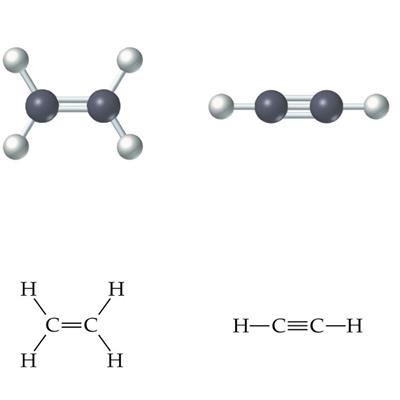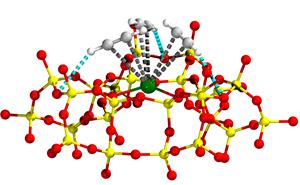Over 350 million tonnes of lower olefins (ethylene, propene and 1,3-butadiene, also known as alkenes) are produced each year. To produce polymers, the alkenes used as starting materials must be pure. Alkynes, present in the products of steam cracking of oil, would poison the polymerisation catalysts and so need to be removed. This removal is costly both economically and environmentally, due to its energy consumption. This study, published in Science, shows a zeolite material that exhibits exceptional adsorption of alkynes from a range of olefin mixtures, and uses neutron diffraction techniques to probe the structure of the zeolite used as well as the binding sites of the alkyne and olefin molecules to uncover the mechanisms behind the selective adsorption.

Left: Illustration of C2H4, an alkene or olefin (left), and C2H2, an alkyne (right). For the neutron experiments, hydrogen atoms were replaced by deuterium, D.
Zeolites can be thought of as molecular sieves: they are structurally robust, cheap and are widely used in many industries. However, the similarities between olefins and alkynes mean that traditional zeolites cannot be used for their separation. Yet, zeolites can act as excellent scaffolds to incorporate active sites thus enabling them to achieve exceptional alkyne adsorption.
The zeolite used in this study, faujasite (FAU), was synthesised in a way that confined active metal sites, such as nickel, copper and zinc, inside the pores. Of these, nickel performed best in their repeated separation experiments, with Ni@FAU able to reversibly capture (a key feature for potential applications) the alkyne at varying concentrations, and from differing mixtures of gases.
When investigating the excellent performance of Ni@FAU, the group found that the synthesis method was key to determining the ability of the material to adsorb alkynes. This led them to conclude that its performance originates from the environment around where the nickel is bound in the structure.
To further investigate the pore environment, the group used neutron powder diffraction on Beamline WISH at the ISIS Pulsed Neutron Source to find the locations of the confined Ni(II) sites and adsorbed deuterated gas molecules (C2D2, C2D4, C3D4, and C3D6) within Ni@FAU. After in-depth analysis, they found that the Ni(II) ions are stabilized by the six-membered cages within the zeolite framework in agreement with computational predication using a technique called Density Functional Theory.
Their structural investigation of the materials once the gases were loaded revealed the crucial difference between the interaction of the material with olefins and alkynes. The additional bonding electrons in C2D2, and its linear geometry, enable the formation of a metastable [Ni(II)(C2D2)3] complex in the pore of the zeolite. However, when a molecule of C2D4 binds, it blocks access to the nickel site by any other C2D4 molecules, leading to the majority of adsorbed C2D4 being stabilized through very weak hydrogen bonds.
Another type of neutron experiment, inelastic neutron scattering (INS) was then performed to understand the binding dynamics of adsorbed C2H2 and C2H4 molecules, experiments were conducted at Oak Ridge National Laboratory. When adsorbed onto Ni(II) sites, the gas molecules studied become isolated and restricted, resulting in distinct vibrational features that are in excellent agreement with the structural investigation and gas separation experiments.

Another type of neutron experiment, inelastic neutron scattering (INS) was then performed to understand the binding dynamics of adsorbed C2H2 and C2H4 molecules, experiments were conducted at Oak Ridge National Laboratory. When adsorbed onto Ni(II) sites, the gas molecules studied become isolated and restricted, resulting in distinct vibrational features that are in excellent agreement with the structural investigation and gas separation experiments.
“Efficient production of polymer-grade lower olefins has a significant impact on the development of future cleaner petrochemical processes." said Dr Sihai Yang, the lead author at The University of Manchester's Department of Chemistry. “It is interesting that by a simple modification of the commercial FAU zeolite, an excellent performance is achieved for the purification of a range of lower olefins from alkene/alkyne mixtures at ambient conditions."
This experiment into Ni@FAU illustrated the feasibility of the production of polymer-grade olefins under conditions relevant to practical processes. Combining its ability for large-scale synthesis and excellent stability, Ni@FAU offers a potential practical solution to the challenging alkyne/olefin separation required by industry.
Further information:
The full paper can be found online at: DOI: 10.1126/science.aay8447
